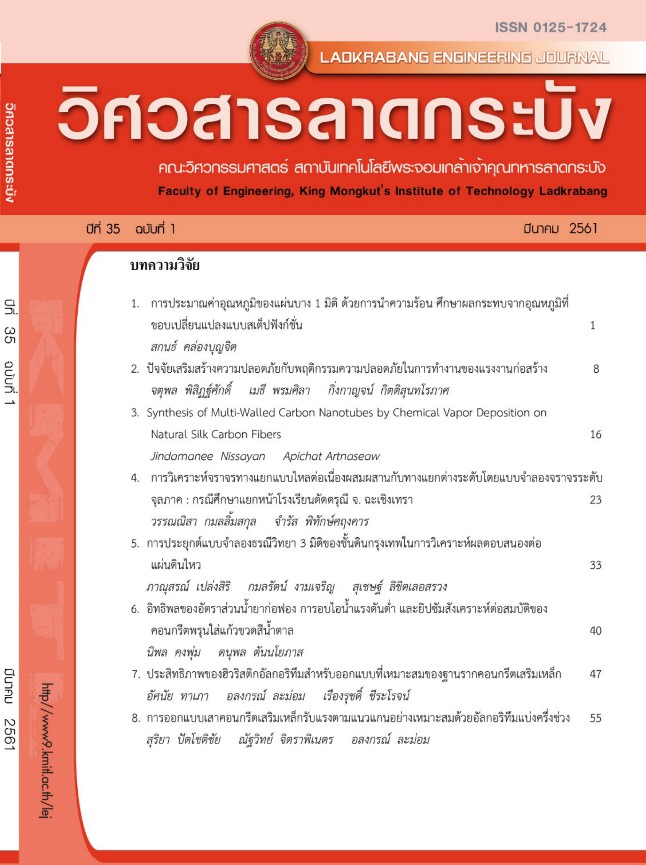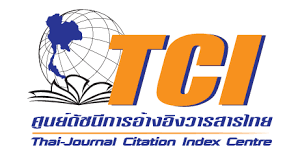The Performance of Heuristic Algorithms for Optimum Design of Reinforced Concrete Foundations
Keywords:
Reinforced concrete foundations, Hill climbing algorithm, Simulated annealing algorithmAbstract
This research introduces applying the heuristic algorithms for optimum design of reinforced concrete foundations which consist of a hill climbing algorithm and simulated annealing algorithm. The objective of this research is to compare the effectiveness of these heuristic algorithms by defining the construction cost as the objective function. Microsoft visual basic 6 was used to develop the optimization process in accordance with the strength design method of the Engineering Institute of Thailand (E.I.T. 1008-38). Four different reinforced concrete foundations were selected from the related literatures and the performance of two heuristic algorithms was evaluated by the statistical results. The results showed that the statistical results of the simulated annealing algorithm were better than the hill climbing algorithm. In addition, the optimum solutions obtained from two heuristic algorithms were an average of 9.24 % better than the traditional method for all examples.
References
L.M. Schneider, “New Era in transportation strategy,” Transportation Strategy, Harvard business review, vol. 63, pp. 118-126, 1985.
I.P. Zaforteza, V. Yepes, A. Hospitaler and F.G. Vidosa, “CO2-optimization of reinforced concrete frames by simulated annealing,” Engineering structures, vol. 31, pp. 1501-1508, 2009.
V. Yepes, J. Alcala, C. Perea and F.G. Vidosa, “A parametric study of optimum earth-retaining walls by simulated annealing,” Engineering structures, vol. 30, pp. 821-830, 2008.
C. Coello and F.S. Hernández, “Optimal design of reinforced concrete beams using genetic algorithms,” Expert systems with applications, vol. 12, pp. 101-108, 1997.
V. Govindaraj and J.V. Ramasamy, “Optimum detailed design of reinforced concrete continuous beams using genetic algorithms,” Computers & structures, vol. 84, pp 34-48, 2005.
D.M. Alex and L. Kottalil, “Genetic algorithm based design of a reinforced concrete continuous beam,” International journal of engineering research & technology, vol. 4, pp. 224-227, 2015.
S. Hassajan, A. Lamom and R. Cheerarot, “Effect of materials selection on the minimum cost for optimal design of reinforced concrete beams using hill climbing algorithm,” KKU research journal, vol. 17, pp. 385-400, 2012.
N. Laoprom, R. Cheerarot and J. Wongpa, “Optimum design of reinforced concrete beams by simulated annealing algorithm,” Research and development journal of the engineering institute of Thailand, vol. 25, pp. 25-37, 2014.
A. Tapown, A. Lamom and R. Cheerarot, “Optimum design of reinforced concrete rectangular column using hill climbing algorithm,” Research and development journal of the engineering institute of Thailand, vol. 23, pp. 28-35, 2012.
A. Tapown, J. Wongpa, A. Lamom and R. Cheerarot, “Optimum design of reinforced concrete biaxial rectangular column using simulated annealing algorithm,” KMUTT research and development journal, vol. 36, pp. 33-50, 2013.
Engineering Institute of Thailand (EIT), “Standard of reinforced concrete building, strength method (E.I.T. 1008-38),” Thailand, 1997.
A.W. Johnson and S.H. Jacobson, “On the convergence of generalized hill climbing algorithms,” Discrete applied mathematics, vol. 119, pp. 37-57, 2002.
D.J. Cross, R. Myers and E.R. Hancock, “Convergence of a hill-climbing genetic algorithm for graph matching,” Pattern recognition, vol. 33, pp. 1863-1880, 2000.
C.D. Kirkpatrick, Jr. Gelatl and M.P. Vecchi, “Optimization by simulated annealing,” Science, vol. 220, pp. 671-680, 1983.
G.P. Potdar and R.C. Thool, “Comparison of various heuristic search techniques for finding shortest path,” International journal of artificial intelligence & applications, vol. 5, pp. 63-74, 2014.
Committee of construction price, “Labor account/operation for estimate and calculate price (revised edition) year 2015,” Bangkok in Thailand, 2015.
V. Chovichien, “Reinforced Concrete Design (Strength Design Method : SMD),” Bangkok in Thailand, 2002.
S. Rukzon, “Reinforced Concrete Structure Design : Strength and Working Design Method,” Bangkok in Thailand, 2012.
Downloads
Published
How to Cite
Issue
Section
License
The published articles are copyrighted by the School of Engineering, King Mongkut's Institute of Technology Ladkrabang.
The statements contained in each article in this academic journal are the personal opinions of each author and are not related to King Mongkut's Institute of Technology Ladkrabang and other faculty members in the institute.
Responsibility for all elements of each article belongs to each author; If there are any mistakes, each author is solely responsible for his own articles.






